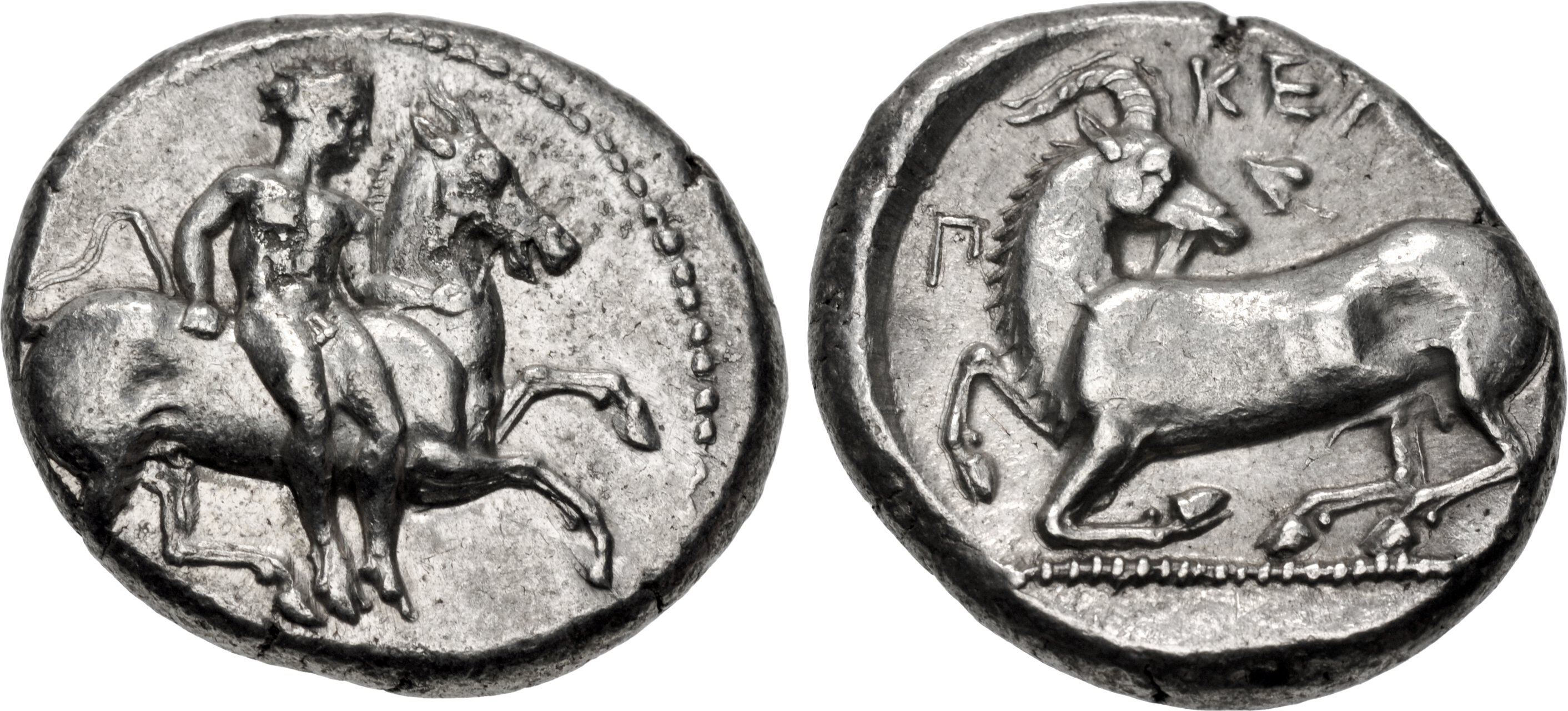S 1797 - Celenderis, silver, double sigloi (410-375 BCE)
From SILVER
410 BCE - 375 BCE Silver 4,195 kg
Description
| ObverseInscription or printing placed on the obverse.: | Nude youth, holding whip in right hand, dismounting from horse rearing right |
| ReverseInscription or printing placed on the reverse.: | KEΛ (Greek).Goat kneeling left, head right, KEΛ and ivy leaf above, Π to left, all within shallow incuse circle |
Mint and issuing power
| MintIdentifies the place of manufacture or issue of a numismatic object.: | Celenderis | Ancient regionAncient region.: | Cilicia | Modern countryModern country: Turkey | AuthorityIdentifies the issuing power. The authority can be "pretended" when the name or the portrait of X is on the coin but he/she was not the issuing power. It can also be "uncertain" when there is no mention of X on the coin but he/she was the issuing power according to the historical sources: | Persian Empire |
Chronology
| FromIdentifies the initial date in a range assigned in a numismatic context. | 410 BCE | toIdentifies the final date in a range assigned in a numismatic context.. | 375 BCE | PeriodTime period of the numismatic object.: Classical 480-323 BC |
Physical description
| MetalThe physical material (usually metal) from which an object is made.: | Silver |
Median weightMedian of the weights of numismatic objects (in grams). in grams | 10.80 | DenominationTerm indicating the value of a numismatic object. Examples: tetradrachm, chalkous, denarius.: | double siglos |
StandardStandard.: | Persian |
Image

S1797 Celenderis double siglos.jpg [1]
References
| Die study referencePublication of the study: | Kraay 19621Kraay 1962, p. 3-6 | ||
| Coin series referenceReference to coin series study: | Sear II2Sear II, n° 5533-5535 | ||
Obverse dies distribution
| FrequencyFrequency of specimen in distribution. ᵖ | Number of obversesNumber of obverse dies. ᵖ (o) | % (o) | Number of coinsNumber of coins. (n) | % (n) | Die nameName(s) of the die(s). |
| 1 | 9 | 52.94 | 9 | 12.16 | 4, 5, 8, 9, 10, 14, 15, 16, 17 |
| 2 | 2 | 11.76 | 4 | 5.41 | 6, 12 |
| 3 | 1 | 5.88 | 3 | 4.05 | 2 |
| 5 | 2 | 11.76 | 10 | 13.51 | 3, 13 |
| 7 | 1 | 5.88 | 7 | 9.46 | 7 |
| 9 | 1 | 5.88 | 9 | 12.16 | 1 |
| 32 | 1 | 5.88 | 32 | 43.24 | 11 |
| Total | 17 of 17 | 99.98 | 74 of 74 | 99.99 |
Reverse dies distribution
no distribution is available
Quantification
| Number of obversesNumber of obverse dies. ᵖ (o) | 17 | Number of singletons (o1)The number of singleton coins. ᵖ | 9 |
| Number of reverse diesNumber of reverse dies. (r) | 14 | Number of coinsNumber of coins. (n) | 74 |
| Coins per obverse dieNumber of coins per obverse die. (n/o) | 4.35 | Coins per reverse dieNumber of coins per reverse die. (n/r) | 5.29 |
| Reverse per obverse ratioRatio of obverse dies divided by reverse dies. (r/o) | 0.82 | Percentage of singletons (o1)number of coins (n) divided by the number of singletons (o1) ᵖ | 52.94 % |
| Original number of dies (O) (Carter 1983 formula)The estimation of the number of coins according to Carter 1983 ᵖ | 19.42 | Coins struck if 20,000 as average productivity per dieCoins made if the average productivity for obverses (according to Carter) is 20,000. ᵖ | 388,400 |
| Original number of dies (O) (Esty 2011 formula)The estimation of the number of coins according to the singleton formula in Esty 2011 ᵖ (O) | 22.07 | Survival rate if 20,000 as average productivity per dieSurvival rate if average productivity is 20,000. ᵖ | 0.00019 |
| Coverage (o = % of O) (Esty 1984 formula)Esty 1984 - coverage (% of O) ᵖ (o = % of O) | 87.84% | Die productivity if survival rate 1/2,000Average productivity if survival rate is 1/2,000. ᵖ | 7,621.01 |
| Weight of silver (in kg) if 20,000 coins per die (O = Carter formula)Carter 1983 * Median weight * 20000 (*10 if gold or electrum) ᵖ | 4,195 kg <br /> 4,195 kg | Die productivity if survival rate 1/5,000Average productivity if survival rate is 1/5,000. ᵖ | 19,052.52 |
Remarks
Most likely one single workstation A die-study from a single hoard, so heavily partial. Probably one workstation, but see the graph, p. 6